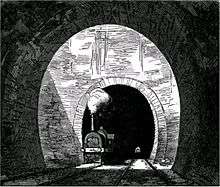Kilsby Tunnel
 Air shaft in the Kilsby Tunnel, illustrated in an 1852 railway publication. | |
| Overview | |
|---|---|
| Location | Northamptonshire |
| Coordinates | Coordinates: 52°19′52″N 1°09′50″W / 52.331°N 1.164°W |
| Start | Kilsby |
| End | Crick |
| Operation | |
| Owner | Network Rail |
| Operator | West Coast Main Line |
| Technical | |
| Track length | 2,223 |
| No. of tracks | Two |
The Kilsby Tunnel is a railway tunnel on the West Coast Main Line railway in England. It was designed and engineered by Robert Stephenson.
The tunnel is located near the village of Kilsby in Northamptonshire roughly 5 miles (8 km) south-east of Rugby and is 2,432 yards (2,224 m) long.
The tunnel was opened in 1838 as a part of the London and Birmingham Railway. It is today the 18th longest tunnel on the British railway system.
The tunnel took far longer, and cost far more money to build than had been anticipated. This was because the tunnel roof collapsed and the tunnel flooded unexpectedly due to quicksand which trial borings into the hill had not revealed. The excess water from the quicksand had to be pumped out, a process which took eight months.[1] Similar problems were encountered with nearby Blisworth tunnel on the Grand Union Canal a few decades earlier.
The length of time it took to build the tunnel delayed the opening of the London and Birmingham Railway.
It took three years, and cost £320,000 to build — three times the original estimate (£23,758,000 in 2005 pounds).[2]
External links
- Kilsby Tunnel includes the classic image of the tunnel under construction.
- A short video of an air shaft by Si Horton using data collected by Colin Humphreys using a Faro Focus X330 laser scanner (on YouTube)
References
- ↑ "Kilsby Tunnel".
- ↑ According to Table 1 of http://www.parliament.uk/commons/lib/research/rp2006/rp06-009.pdf, the RPI index in 1838 was 10.2 and had risen to 757.3 in 2005, giving a conversion factor of 74.245.